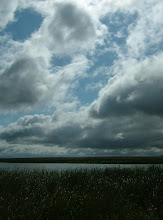 On the border between North Dakota and South Dakota, there stands a new wind farm. With 61 towers on the north side of the state line and 59 on the south side, it is a magnificent sight. The towers are in a linear cluster that is perpendicular to the direction of prevailing winds, so that it runs southwest to northeast. It runs along a slight rise that interrupts the otherwise flat plains landscape, called the Coteau des Prairies Ridge. Much of the land in this area, due to the sandy soil and the hilly undulating topography is dedicated to cattle pasture rather than crops, and the cattle do graze unfazed by their new neighbors. Approaching from the west, with the low afternoon sun behind the car, the towers glowed white under the white clouds.
On the border between North Dakota and South Dakota, there stands a new wind farm. With 61 towers on the north side of the state line and 59 on the south side, it is a magnificent sight. The towers are in a linear cluster that is perpendicular to the direction of prevailing winds, so that it runs southwest to northeast. It runs along a slight rise that interrupts the otherwise flat plains landscape, called the Coteau des Prairies Ridge. Much of the land in this area, due to the sandy soil and the hilly undulating topography is dedicated to cattle pasture rather than crops, and the cattle do graze unfazed by their new neighbors. Approaching from the west, with the low afternoon sun behind the car, the towers glowed white under the white clouds.This wind farm, named Tatanka, has a generating capacity of 180 megawatts, which they say is enough for over 60,000 homes. Compare this to the largest coal-burning electric plant in North Dakota, Coal Creek Station, that produces around 1000 megawatts, at the cost of 8 million tons of coal per year. This wind farm, then, makes about the same amount of energy as 1.5 million tons of coal. Just 6 wind farms like this could replace that coal-burning plant. Considering that it felt like I drove for miles and miles to get to it, and that it was relatively unobtrusive on the horizon when I finally got to it, that would seem like a pretty fair trade.

2 comments:
I think if you change this sentence:
Compare this to the largest coal-burning electric plant in North Dakota, Coal Creek Station, that produces around 1000 megawatts a year, at the cost of 8 million tons of coal.
To this:
Compare this to the largest coal-burning electric plant in North Dakota, Coal Creek Station, that produces around 1000 megawatts, at the cost of 8 million tons of coal per year.
It will resolve a minor (and only techical) difficulty. The unit of measure "Watt" is an instantaneous unit (e.g., A 60 watt bulb consumes 60 watts of power whenever it's on). Energy is measured in Watt-hours or megawatt-years (e.g., a 60 watt bulb running for 1 hour consumes 60 watt-hours of energy). The above quotes of 1000 and 180 megawatts are instantaneous measure. Over a year period, the coal plant consumes 8M tons of coal to generate 1000 Mwatt-years of energy.
All of your analysis and conclusions remain the same.
Great thought and an exciting thought at that.
No need to post this comment.
change made. good catch.
another factor is that these numbers are usually max production, or potentiol production, and they rarely operate at max. to compare fairly, one needs avarage production numbers. coal plants go in and out of production due to cost of coal compared to other things which affects price which affects demand and wind goes in and out of production based on windless days. both can reduce production based on surplus of energy from other sources or low demand for any reason. if the wind farm has been engineered to meet demands some number of years out and will only run at partial capacity in the beginning, maybe because that is what the existing power grid can handle, then comparing it to a power plant running at nearer capacity might not be fair, for example.
Post a Comment